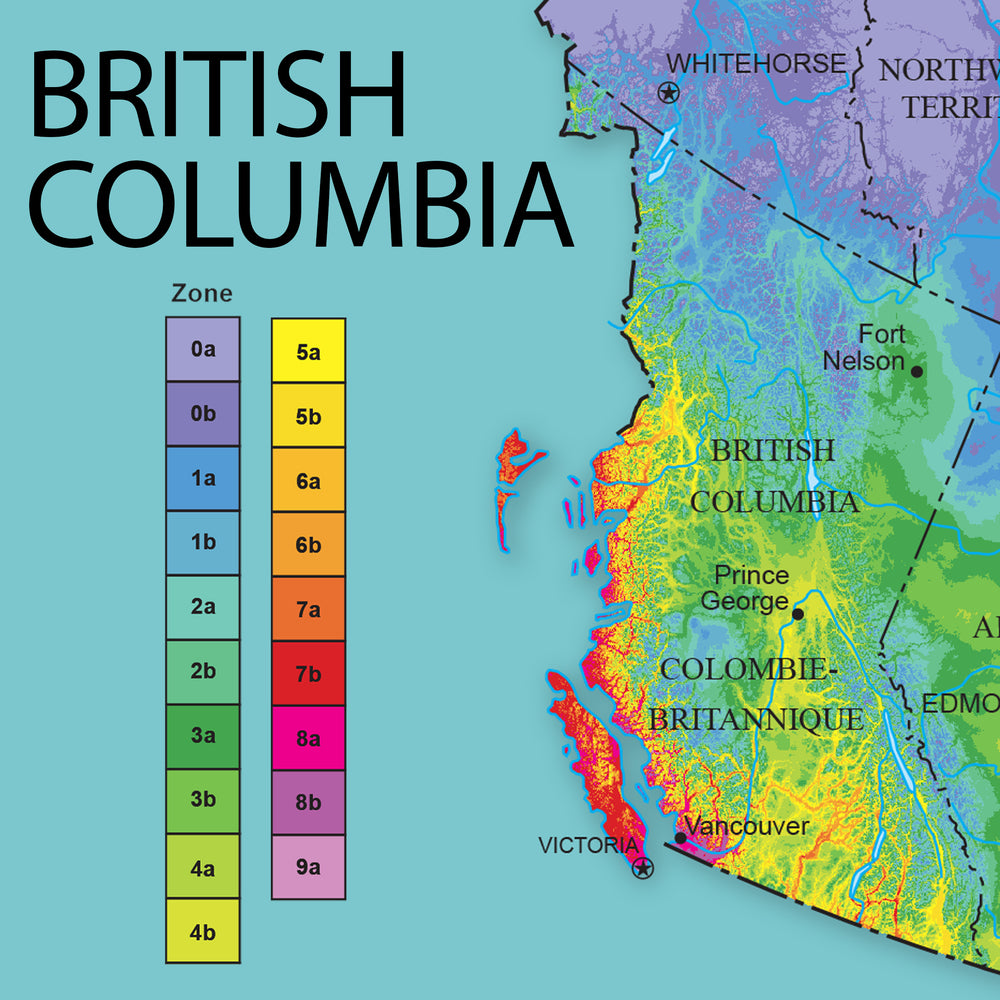Image from Natural Resources Canada
Characteristics of British Columbia Planting Region
British Columbia is a large province with an incredibly diverse climate that varies significantly across the region.
- The southern coastal areas experience a warm, rainy climate with very mild winters making it a great region for growing throughout the year.
- The central interior of the province has a semi-arid climate and is characterized by hot summers with temperatures frequently reaching above 30°C accompanied by cold winters with abundant snowfall.
- Finally, the northern region typically experiences short, cool summers and long, cold winters with heavy snowfall. The province is prone to extreme heatwaves and wildfires, creating a challenging environment for growing throughout the summer in certain areas.
The southern part of the region will experience a much longer growing season than those living up north. It’s best to search for frost-free periods specific to where you live in order to maximize your planting season.
 Sea to Sky Highway, British Columbia, Canada | Photo by Tom Winckels on Unsplash
Sea to Sky Highway, British Columbia, Canada | Photo by Tom Winckels on Unsplash
Challenges of Growing in British Columbia
1. Extreme weather
Severe weather events such as heatwaves and wildfires take a serious toll on gardens in the area. To keep your plants protected, it’s best to utilize indoor growing during extreme weather periods.
2. Climate diversity
The wide range of planting zones across the province means the climate drastically varies over shorter distances. Understanding your exact growing zone is vital to ensure your plants are appropriate for your region.
3. High Altitude
The mountainous region of British Columbia may experience a variety of gardening challenges. Low humidity, sudden temperature changes, poor soul characteristics, heavy snowfall and high-intensity sunlight, are all to be expected in the higher elevation regions of the province.
 Nelson, British Columbia | Photo by Kateryna T on Unsplash
Nelson, British Columbia | Photo by Kateryna T on Unsplash
The Benefits of Using a Greenhouse in British Columbia
Using a greenhouse in this region provides many benefits for gardeners. For those living in the northern area of British Columbia, it will help extend the growing season and protect your plants from heavy snowfall.
Gardeners in the central region will be able to regulate temperatures to keep their plants from wilting during the hotter months. Finally, those in the southern and coastal areas of the province can extend the growing season throughout the whole year.
1. Extend your Growing Season
-
Without a Greenhouse:
The standard outdoor growing season in British Columbia typically varies between 3-4 months across the province. While those in the south have more flexibility in terms of vegetable options, those further north are very limited in what they can plant.
-
With a Greenhouse:
Everyone throughout British Columbia can significantly extend their growing season with a greenhouse. For example, those further north can expect anywhere between 7-9 months of planting time, whereas those living in southern BC can use a greenhouse to grow year-round.
So for those hunting for a greenhouse for sale in British Columbia or backyard greenhouse kits Vancouver, then get in touch with our team of greenhouse experts today.
 Customer image of the Astra greenhouse in Port McNeill, British Columbia
Customer image of the Astra greenhouse in Port McNeill, British Columbia
 Customer image of the Sungrow greenhouse in Burns Lake, British Columbia
Customer image of the Sungrow greenhouse in Burns Lake, British Columbia
2. Grow a Wider Variety of Vegetables
-
Without a Greenhouse:
The standard outdoor growing season in British Columbia typically varies between 3-4 months across the province. While those in the south have more flexibility in terms of vegetable options, those further north are very limited in what they can plant.
- Lettuce
- Broccoli
- Brussel Sprouts
- Cabbage
- Collards
- Spinach
- Kale
- Radishes
-
With a Greenhouse:
The climate in British Columbia varies drastically across the province. However, using a greenhouse will allow you to expand your vegetable options, regardless of where you’re located. The following vegetables will thrive in a greenhouse across the region:
- Potatoes
- Sweet Corn
- Pumpkins
- Squash
- Zucchini
- Carrots
- Peas
- Asparagus
- Beets
- Arugula
- Swiss chard
- Okra
- Habanero Peppers
- Jalapeños
- Green Beans
- Lima Beans
- Celery
- Cauliflower
- Eggplant
- Artichoke

Pumpkin patch | Photo by Steffi Pereira on Unsplash
Why Planta Greenhouses?
- Wind resistant up to 65 mph (learn more about how our greenhouses hold up in high-altitude climates).
- Withstands a snow load of up to 98 psf (480kg/square meter).
- Made with a heavy-duty galvanized steel frame.
- Polycarbonate panels provide 100% protection against UV rays.
- The Sungrow greenhouse is bell-shaped - allows the wind, snow, and hail to slide off the sides.
- Extendable (Sungrow, Sigma and Farmer models can be extended beyond 100ft)
- Made in Europe and are exclusively imported
- Maintenance-free

